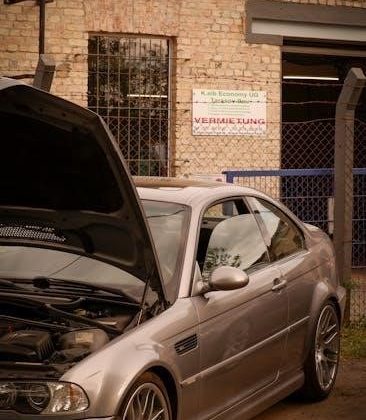honeywell pro 5000 manual
Welcome to the Honeywell Pro 5000 Manual, your comprehensive guide to installing, operating, and troubleshooting this advanced non-programmable digital thermostat. Designed for ease of use, this manual ensures smooth operation and optimal performance of your heating and cooling systems. Explore installation steps, special features, and troubleshooting tips to maximize efficiency and comfort in your smart home setup.
1;1 Overview of the Honeywell Pro 5000 Thermostat
The Honeywell Pro 5000 is a non-programmable digital thermostat designed for precise temperature control in residential and light commercial settings. It offers a straightforward interface with a backlit display, making it easy to read and adjust settings. Compatible with both conventional and heat pump systems, this thermostat ensures efficient heating and cooling. Its compact design and user-friendly features make it a popular choice for smart home upgrades. The Pro 5000 supports various wiring configurations and operates on a 24VAC power supply. With its robust construction and reliable performance, it is ideal for maintaining consistent indoor comfort while optimizing energy usage. This thermostat is part of Honeywell’s FocusPRO series, known for its durability and advanced functionality.
1.2 Importance of the Manual for Installation and Operation
The Honeywell Pro 5000 manual is a critical resource for ensuring proper installation, configuration, and operation of the thermostat. It provides detailed step-by-step instructions, safety guidelines, and troubleshooting tips to help users avoid common mistakes. The manual is essential for understanding the thermostat’s advanced features and optimizing its performance. By following the guidelines, users can ensure a safe and efficient setup, preventing potential damage to the system. Additionally, the manual serves as a reference for maintaining optimal temperature control and addressing any issues that may arise during operation. Whether you’re a homeowner or a technician, this manual is indispensable for maximizing the thermostat’s functionality and extending its lifespan.

Installation Guide
The Honeywell Pro 5000 manual provides a detailed installation guide, covering wallplate setup, power requirements, wiring for conventional and heat pump systems, and thermostat mounting for a seamless setup.
2;1 Wallplate Installation Instructions
Begin by preparing the wall surface, ensuring it is clean and dry. Align the wallplate with the mounting screws, securing it firmly to the wall. Use a level to ensure proper alignment for accurate thermostat operation. Gently snap the thermostat onto the wallplate, ensuring it clicks securely into place. Verify that all wires are properly connected and tucked neatly behind the wallplate to avoid interference. The wallplate is designed to fit standard electrical boxes, making installation straightforward. Follow the provided screws and hardware for a secure fit. Proper installation ensures reliable performance and prevents potential issues. Refer to the manual for specific torque settings to avoid over-tightening. Once installed, test the thermostat to confirm it powers on and functions correctly.

2.2 Power Options and Requirements
The Honeywell Pro 5000 thermostat operates on 24V AC power, typically requiring a common wire (C-wire) for consistent operation. It is compatible with most HVAC systems, including conventional and heat pump configurations. For systems without a C-wire, optional power stealing or battery-powered operation is available. Ensure your system meets the voltage requirements (20-30V AC) to avoid damage. The thermostat is designed to work with single-stage or multi-stage systems, providing reliable performance. Always turn off power at the circuit breaker before installation to ensure safety. Refer to the manual for specific wiring diagrams and power requirements tailored to your system type. Proper power setup is crucial for optimal functionality and to prevent malfunctions. The Pro 5000 is engineered to be energy-efficient and compatible with a wide range of heating and cooling systems.
2.3 Wiring Conventional Systems

Wiring the Honeywell Pro 5000 for conventional systems involves connecting the appropriate terminals to your HVAC system. The R (24V) terminal connects to the heating and cooling system’s power source. The W terminal links to the heating stage, while the Y terminal connects to the cooling stage. The G terminal controls the fan, and the C (common) terminal is required for consistent power supply. For systems without a C-wire, power stealing or battery operation is an option. Ensure all wires are securely connected to avoid loose connections, which can cause malfunctions. Refer to the wiring diagram in the manual for specific configurations. Always turn off power at the circuit breaker before starting installation. Proper wiring ensures reliable operation and prevents damage to the thermostat or HVAC system. Follow the manufacturer’s guidelines for a safe and efficient setup.
2.4 Wiring Heat Pump Systems
Wiring the Honeywell Pro 5000 for heat pump systems requires careful connection to ensure proper operation; Connect the R terminal to the 24V power source, and the W terminal to the heating stage. The Y terminal links to the cooling stage, while the G terminal controls the fan operation. For heat pumps, the O/B terminal is essential for reversing valve control, determining whether the system is in heating or cooling mode. Ensure the O/B wire is correctly connected to match your system’s configuration. If your system requires it, connect the C (common) terminal for consistent power supply. Refer to the wiring diagram in the manual for specific heat pump configurations. Always turn off power at the circuit breaker before starting. Proper wiring ensures seamless operation of your heat pump system, avoiding potential issues like incorrect mode operation or system damage.
2.5 Thermostat Mounting Process
Mounting the Honeywell Pro 5000 thermostat is a straightforward process that ensures proper installation and functionality. Begin by attaching the wallplate to a flat surface, ensuring it is level and securely fastened. Use the provided screws or anchors to fix the wallplate to the wall. Once the wallplate is in place, gently align the thermostat with the mounting tabs and press firmly until it clicks into position. Make sure the thermostat is level and evenly seated to avoid any operational issues. For optimal performance, mount the thermostat in a location with good airflow, away from direct sunlight or drafts. After mounting, double-check all connections to ensure they are secure and properly aligned. This step ensures your Honeywell Pro 5000 operates efficiently and accurately controls your heating and cooling system.
Features and Functionalities
The Honeywell Pro 5000 offers a non-programmable design, smart home compatibility, and special functions for efficient temperature control, ensuring optimal performance and system protection.
3.1 Special Functions of the Honeywell Pro 5000
The Honeywell Pro 5000 features advanced functions like temperature regulation, smart home compatibility, and system protection. Its non-programmable design simplifies operation while maintaining precise control over heating and cooling systems.
The thermostat includes special functions such as automatic temperature adjustment, compatibility with heat pumps, and conventional HVAC systems. It also offers protection for compressors and prevents short cycling, ensuring system longevity.
With its user-friendly interface, the Honeywell Pro 5000 allows seamless integration with smart home systems, enhancing convenience and energy efficiency. These features make it an ideal choice for modern homes seeking reliable and intelligent temperature control solutions.
3.2 Operating the Thermostat
Operating the Honeywell Pro 5000 is straightforward and intuitive. The thermostat features a digital interface with clear buttons for adjusting temperature settings. Users can easily switch between heating and cooling modes or set the fan to run continuously for consistent air circulation.
The thermostat also allows for manual temperature adjustments, with the ability to set specific comfort levels. Its non-programmable design ensures simplicity, making it ideal for users who prefer direct control without complex scheduling.
Additionally, the Honeywell Pro 5000 is compatible with smart home systems, enabling remote operation through compatible platforms. This feature enhances convenience and energy efficiency, allowing users to manage their home climate effortlessly from anywhere.
3.3 Compatibility with Smart Home Systems
The Honeywell Pro 5000 is designed to integrate seamlessly with smart home systems, offering enhanced convenience and energy efficiency. It is compatible with popular platforms like Honeywell Home and other smart home hubs, allowing users to control their thermostat remotely through smartphone apps.
This compatibility enables features such as voice control via Amazon Alexa or Google Assistant, making it easy to adjust settings hands-free. Additionally, the thermostat can be programmed to work with geofencing technology, automatically adjusting temperatures based on your location.
By integrating with smart home systems, the Honeywell Pro 5000 provides a modern, connected experience, ensuring optimal comfort and energy savings without compromising on simplicity and ease of use.
Technical Specifications
The Honeywell Pro 5000 features a backlit display, compatibility with most HVAC systems, and operates within a temperature range of 45°F to 90°F (7°C to 32°C).
4.1 Key Specifications of the Honeywell Pro 5000

The Honeywell Pro 5000 is a non-programmable digital thermostat designed for compatibility with most HVAC systems; It features a large, backlit display for easy readability and operates within a temperature range of 45°F to 90°F (7°C to 32°C). The thermostat supports both conventional and heat pump systems, making it versatile for various home setups. It requires a 24V AC power supply and is compatible with single-stage or multi-stage systems. Additional features include a built-in time guard, which protects the compressor, and a permanent memory retention to save settings during power outages. The thermostat is lightweight and compact, designed for easy wall mounting. Its durable construction ensures long-term reliability, while its user-friendly interface simplifies temperature control. These specifications make the Honeywell Pro 5000 a reliable and efficient choice for home climate control.
4.2 Environmental and Operational Requirements
The Honeywell Pro 5000 operates effectively in environments with temperatures between 32°F and 90°F (0°C to 32°C) and relative humidity up to 80%. It is designed for indoor use only and should be protected from direct sunlight, moisture, and extreme temperature fluctuations. The thermostat requires a stable 24V AC power supply and must be properly grounded to ensure safe operation. It is compatible with both conventional and heat pump systems, including single-stage and multi-stage configurations. For optimal performance, the device should be installed in a location with good airflow and minimal vibration. Additionally, the Honeywell Pro 5000 is designed to work with standard HVAC wiring configurations, ensuring compatibility with most residential systems. Always follow local electrical codes and safety guidelines during installation and operation.
4.3 Included Components and Accessories
The Honeywell Pro 5000 thermostat package includes essential components for a seamless installation and operation experience. The package contains the thermostat unit, a wallplate, and a cover plate assembly (Part No. 50001137-001 or 50002883-001); Additional accessories include wiring labels, mounting screws, and a battery compartment. The thermostat is pre-equipped with a 24V AC transformer for power supply. For proper installation, ensure all included components are used as specified in the manual. Optional accessories, such as remote sensors or smart home integration modules, may be purchased separately to enhance functionality. Always verify the compatibility of any additional accessories with the Honeywell Pro 5000 to maintain optimal performance and warranty validity. Proper use of included components ensures safe and efficient operation of your HVAC system.

Troubleshooting Common Issues
Address common problems like display issues, wiring faults, or thermostat malfunctions by checking connections, ensuring proper power supply, and referring to the manual for detailed solutions and repairs.
5.1 Common Problems and Solutions
Common issues with the Honeywell Pro 5000 include display malfunctions, incorrect temperature readings, and wiring faults. For display problems, ensure proper power supply and check connections. If the thermostat doesn’t respond, reset it by turning power off and on. Incorrect temperature readings may result from improper calibration or sensor issues. Refer to the manual for calibration steps. Wiring faults, such as loose connections, can cause system malfunctions. Verify all wires are securely connected to the correct terminals. For heat pump systems, ensure the reversing valve is properly configured. If issues persist, consult the troubleshooting section or contact Honeywell support for assistance. Always follow safety guidelines when handling electrical components.
5.2 Display Issues and Resolutions
Display issues with the Honeywell Pro 5000, such as a blank or flickering screen, can often be resolved with simple troubleshooting steps. First, ensure the thermostat is properly powered. Check the circuit breaker or fuse to confirm power supply. If the display remains blank, verify that all wiring connections are secure and correct. Loose wires or incorrect terminal connections can cause display malfunctions. For flickering screens, try resetting the thermostat by turning the power off and on. If the issue persists, refer to the manual for calibration instructions or perform a factory reset. In rare cases, a faulty display may require professional repair or replacement. Always consult the troubleshooting guide or contact Honeywell support for further assistance if problems continue.

5.3 Wiring and Connection Troubleshooting

Wiring and connection issues are common challenges when installing or operating the Honeywell Pro 5000 thermostat; Ensure all wires are securely connected to the correct terminals, as loose connections can cause system malfunctions; For conventional systems, verify that the red wire is connected to the R terminal and the white wire to the W terminal for cooling. For heat pumps, the yellow wire should be connected to the Y terminal, and the orange wire to the O terminal. If the thermostat fails to power on, check the circuit breaker or fuse. Incorrect wiring, such as reversed connections, can lead to improper heating or cooling. Refer to the wiring diagram in the manual for specific configurations. If issues persist, consult a licensed technician or contact Honeywell support for further assistance.
5.4 Thermostat Malfunction and Repair

If the Honeywell Pro 5000 thermostat malfunctions, start by checking the power supply and ensuring all connections are secure. Common issues include display problems, incorrect temperature readings, or system failure to activate. Reset the thermostat by turning it off, waiting 30 seconds, and turning it back on. For display issues, gently clean the screen with a soft cloth. If the thermostat fails to respond, verify wiring connections and consult the manual. For persistent problems, contact Honeywell support or a certified technician. Refer to the troubleshooting section for specific solutions. Part No. 50001137-001 and 50002883-001 are key components for repairs. Returns can be sent to Honeywell Return Goods, Dock 4, MN10-3860, 1885 Douglas Dr. Always follow manufacturer guidelines for repairs to avoid further damage.

Customer Assistance and Support
Honeywell offers comprehensive support for the Pro 5000 thermostat, including online resources, manuals, and warranty services. Contact Honeywell Support at MN10-3860, 1885 Douglas Dr., for assistance and repairs.
6.1 Contact Information for Honeywell Support
For assistance with your Honeywell Pro 5000 thermostat, contact Honeywell Support at their headquarters located at MN10-3860, 1885 Douglas Dr. You can reach their customer service team by calling 1-800-468-1502. Additionally, visit their official website at customer.honeywell.com for online resources, manuals, and troubleshooting guides. For warranty inquiries or repair services, email their support team at support@honeywell.com. Honeywell is committed to providing reliable and efficient solutions to ensure your thermostat operates at its best.
6.2 Online Resources and Manuals
Honeywell provides extensive online resources to support your Pro 5000 thermostat. Visit their official website at customer.honeywell.com to access the complete installation manual, troubleshooting guides, and technical specifications. The FocusPRO 5000 Series manual is available for download in PDF format, ensuring you have all the information needed for seamless installation and operation. Additionally, Honeywell offers a dedicated technical literature page where you can find detailed instructions and diagrams. These resources are designed to help you maximize the functionality of your thermostat and resolve any issues quickly. Utilize these online tools to ensure optimal performance and efficiency of your Honeywell Pro 5000 thermostat.
6.3 Warranty Information and Repair Services
The Honeywell Pro 5000 thermostat is backed by a comprehensive warranty program, ensuring protection for your investment. For detailed warranty terms, visit Honeywell’s official website or refer to the provided service manual. Repairs are facilitated through Honeywell’s Return Goods department, located at MN10-3860, 1885 Douglas Dr. To initiate a repair, contact Honeywell Support for authorization and instructions. Genuine Honeywell parts, such as the Cover Plate Assembly (Part No. 50001137-001 or 50002883-001), are recommended to maintain warranty validity. Professional technicians handle repairs to ensure compliance with manufacturer standards. For additional assistance, download the service manual from Honeywell’s resource library or contact their customer support team. This ensures your thermostat operates efficiently and maintains its performance over time.
In conclusion, the Honeywell Pro 5000 Manual provides essential guidance for installation, operation, and troubleshooting. Follow the instructions to optimize your thermostat’s performance and enhance your smart home experience.
7.1 Summary of Key Points
The Honeywell Pro 5000 Manual is a detailed guide for installing, operating, and maintaining your thermostat. It covers wallplate installation, power options, and wiring for both conventional and heat pump systems. The manual also highlights special functions, such as compatibility with smart home systems, and provides troubleshooting solutions for common issues. Key specifications, environmental requirements, and included components are outlined to ensure optimal performance. Customer assistance resources, including contact information and warranty details, are provided for additional support. By following this manual, users can efficiently manage their heating and cooling systems, ensuring comfort and energy efficiency. Refer to the troubleshooting section for quick solutions to common problems, and utilize online resources for further assistance. This guide is essential for maximizing the functionality of your Honeywell Pro 5000 thermostat.
7.2 Final Tips for Optimal Use
To ensure the best performance from your Honeywell Pro 5000 thermostat, regular maintenance is essential. Always update the firmware to access the latest features and improvements. Adjust temperature settings seasonally to optimize energy savings and comfort. For smart home users, integrate the thermostat with compatible systems for seamless control; Periodically clean the display and sensors to maintain accuracy. If issues arise, refer to the troubleshooting section before contacting support. Schedule professional checks annually to ensure proper system operation. By following these tips, you can extend the lifespan of your thermostat and enjoy consistent, efficient heating and cooling. Remember to save your preferred settings to avoid resets during power outages. Happy heating and cooling with your Honeywell Pro 5000!


























































































